TP-Link TL-ER604W User Manual
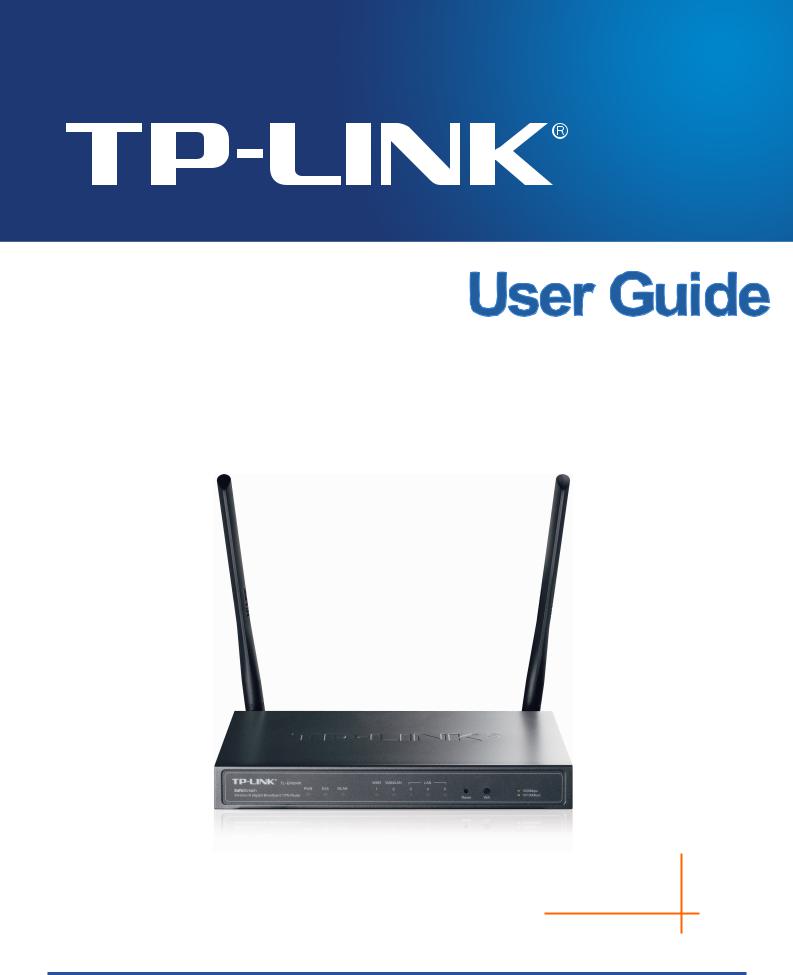
TL-ER604W
 Wireless N Gigabit Broadband VPN Router
Wireless N Gigabit Broadband VPN Router
Rev1.0.1
1910010844

COPYRIGHT & TRADEMARKS
Specifications are subject to change without notice.  is a registered trademark of TP-LINK TECHNOLOGIES CO., LTD. Other brands and product names are trademarks of their respective holders.
is a registered trademark of TP-LINK TECHNOLOGIES CO., LTD. Other brands and product names are trademarks of their respective holders.
No part of the specifications may be reproduced in any form or by any means or used to make any derivative such as translation, transformation, or adaptation without permission from TP-LINK TECHNOLOGIES CO., LTD. Copyright © 2013 TP-LINK TECHNOLOGIES CO., LTD. All rights reserved.
http://www.tp-link.com
FCC STATEMENT
This equipment has been tested and found to comply with the limits for a Class A digital device, pursuant to part 15 of the FCC Rules. These limits are designed to provide reasonable protection against harmful interference when the equipment is operated in a commercial environment. This equipment generates, uses, and can radiate radio frequency energy and, if not installed and used in accordance with the instruction manual, may cause harmful interference to radio communications. Operation of this equipment in a residential area is likely to cause harmful interference in which case the user will be required to correct the interference at his own expense.
This device complies with part 15 of the FCC Rules. Operation is subject to the following two conditions:
1)This device may not cause harmful interference.
2)This device must accept any interference received, including interference that may cause undesired operation.
Any changes or modifications not expressly approved by the party responsible for compliance could void the user’s authority to operate the equipment.
CE Mark Warning
This is a class A product. In a domestic environment, this product may cause radio interference, in which case the user may be required to take adequate measures.
-I-
|
|
|
CONTENTS |
Package Contents.................................................................................................................. |
1 |
||
Chapter 1 About this Guide ................................................................................................... |
2 |
||
1.1 |
Intended Readers .................................................................................................................. |
2 |
|
1.2 |
Conventions ........................................................................................................................... |
2 |
|
1.3 |
Overview of this Guide........................................................................................................... |
2 |
|
Chapter 2 Introduction .......................................................................................................... |
3 |
||
2.1 |
Overview of the Router .......................................................................................................... |
3 |
|
2.2 |
Features................................................................................................................................. |
4 |
|
2.3 |
Appearance............................................................................................................................ |
6 |
|
|
2.3.1 |
Front Panel ................................................................................................................ |
6 |
|
2.3.2 |
Rear Panel................................................................................................................. |
7 |
Chapter 3 Configuration ........................................................................................................ |
8 |
||
3.1 |
Network.................................................................................................................................. |
8 |
|
|
3.1.1 |
Status......................................................................................................................... |
8 |
|
3.1.2 |
System Mode............................................................................................................. |
8 |
|
3.1.3 |
WAN ........................................................................................................................ |
10 |
|
3.1.4 |
LAN.......................................................................................................................... |
27 |
|
3.1.5 |
MAC Address........................................................................................................... |
30 |
|
3.1.6 |
Switch ...................................................................................................................... |
31 |
3.2 |
Wireless ............................................................................................................................... |
37 |
|
|
3.2.1 |
Wireless Setting....................................................................................................... |
37 |
|
3.2.2 |
MAC Filtering ........................................................................................................... |
50 |
|
3.2.3 |
Host Status .............................................................................................................. |
51 |
3.3 |
User Group .......................................................................................................................... |
52 |
|
|
3.3.1 |
Group....................................................................................................................... |
52 |
|
3.3.2 |
User ......................................................................................................................... |
53 |
|
3.3.3 |
View......................................................................................................................... |
54 |
|
|
|
-II- |
3.4 |
Advanced ............................................................................................................................. |
55 |
|
|
3.4.1 |
NAT .......................................................................................................................... |
55 |
|
3.4.2 |
Traffic Control .......................................................................................................... |
63 |
|
3.4.3 |
Session Limit ........................................................................................................... |
66 |
|
3.4.4 |
Load Balance ........................................................................................................... |
68 |
|
3.4.5 |
Routing .................................................................................................................... |
72 |
3.5 |
Firewall................................................................................................................................. |
77 |
|
|
3.5.1 |
Anti ARP Spoofing ................................................................................................... |
77 |
|
3.5.2 |
Attack Defense ........................................................................................................ |
80 |
|
3.5.3 |
MAC Filtering ........................................................................................................... |
82 |
|
3.5.4 |
Access Control ......................................................................................................... |
82 |
|
3.5.5 |
App Control .............................................................................................................. |
88 |
3.6 |
VPN |
...................................................................................................................................... |
89 |
|
3.6.1 |
IKE ........................................................................................................................... |
90 |
|
3.6.2 ........................................................................................................................ |
IPsec |
94 |
|
3.6.3 ............................................................................................................ |
L2TP/PPTP |
100 |
3.7 |
Services ............................................................................................................................. |
104 |
|
|
3.7.1 ........................................................................................................ |
PPPoE Server |
104 |
|
3.7.2 ............................................................................................................... |
E - Bulletin |
109 |
|
3.7.3 ........................................................................................................ |
Dynamic DNS |
111 |
|
3.7.4 ..................................................................................................................... |
UPnP |
116 |
3.8 |
Maintenance ...................................................................................................................... |
117 |
|
|
3.8.1 .......................................................................................................... |
Admin Setup |
117 |
|
3.8.2 .......................................................................................................... |
Management |
120 |
|
3.8.3 .................................................................................................................. |
License |
122 |
|
3.8.4 ................................................................................................................. |
Statistics |
123 |
|
3.8.5 ............................................................................................................ |
Diagnostics |
125 |
|
3.8.6 ....................................................................................................................... |
Time |
127 |
-III-
|
3.8.7 |
Logs....................................................................................................................... |
128 |
Chapter 4 Application........................................................................................................ |
130 |
||
4.1 |
Network Requirements....................................................................................................... |
130 |
|
4.2 |
Network Topology............................................................................................................... |
131 |
|
4.3 |
Configurations.................................................................................................................... |
131 |
|
|
4.3.1 |
Internet Setting ...................................................................................................... |
131 |
|
4.3.2 |
VPN Setting ........................................................................................................... |
133 |
|
4.3.3 |
Network Management............................................................................................ |
139 |
|
4.3.4 |
Network Security.................................................................................................... |
143 |
Appendix A |
Hardware Specifications ........................................................................... |
148 |
|
Appendix B |
FAQ ......................................................................................................... |
149 |
|
Appendix C |
Glossary .................................................................................................. |
151 |
|
-IV-

Package Contents
The following items should be found in your package:
One TL-ER604W Router
One Power Adapter
One RJ45 Ethernet Cable
Quick Installation Guide
Resource CD
 Note:
Note:
Make sure that the package contains the above items. If any of the listed items is damaged or missing, please contact with your distributor.
-1-

Chapter 1 About this Guide
This User Guide contains information for setup and management of TL-ER604W Router. Please read this guide carefully before operation.
1.1 Intended Readers
This Guide is intended for Network Engineer and Network Administrator.
1.2 Conventions
In this Guide the following conventions are used:
The Router or TL-ER604W mentioned in this Guide stands for TL-ER604W SafeStream Wireless N Gigabit Broadband VPN Router without any explanation.
Menu Name→Submenu Name→Tab page indicates the menu structure. Advanced→NAT
→Basic NAT means the Basic NAT page under the NAT menu option that is located under the Advanced menu.
Bold font indicates a toolbar icon, menu or menu item.
<Font> indicate a button.
Symbols in this Guide:
Symbol Description
 Note: Ignoring this type of note might result in a malfunction or damage to the device.
Note: Ignoring this type of note might result in a malfunction or damage to the device.
Tips: This format indicates important information that helps you make better use of your device.
1.3 Overview of this Guide
Chapter 1 About This Guide |
Introduces the guide structure and conventions. |
Chapter 2 Introduction |
Introduces the features and appearance of this router. |
Chapter 3 Configuration |
Introduces how to configure the Router via Web management |
|
page. |
Chapter 4 Application |
Introduces the practical application of the Router on the |
|
enterprise network. |
Appendix A Hardware Specifications |
Lists the hardware specifications of this router. |
Appendix B FAQ |
Provides the possible solutions to the problems that may |
|
occur during the installation and operation of the router. |
Appendix C Glossary |
Lists the glossary used in this guide. |
|
-2- |
Chapter 2 Introduction
Thanks for choosing the SafeStream Wireless N Gigabit Broadband VPN Router TL-ER604W.
2.1 Overview of the Router
The SafeStream Wireless N Gigabit Broadband VPN Router TL-ER604W from TP-LINK supports Wireless N speed and Gigabit wired speeds on all ports. It integrates multiple VPN protocols, high-security and high-performance VPN capabilities, making it an ideal choice for branch offices in need of cost-effective secure remote connections to headquarters or remote offices. Furthermore, together with many useful features including hardware-based WiFi On/Off button, Guest Networking, App Control, and PPPoE Server functions, TL-ER604W is an ideal network solution for home or small office consumers.
Powerful Data Processing Capability
+Built-in MIPS 32 network processor and 64MB DDRII high-speed RAM allows the stability and reliability for operation.
Wireless Feature
+Wireless N speed provides an incredible high speed experience.
+Supporting Guest Networking feature, which provides a secure network for guests outside of the existing, potentially sensitive LAN.
+Hardware Wi-Fi On/Off button provides an easy way to turn wireless radio on or off
Virtual Private Network (VPN)
+Providing comprehensive IPsec VPN with DES/3DES/AES encryptions, MD5/SHA1 identifications and automatically/manually IKE Pre-Share Key exchanges.
+Supporting PPTP/L2TP VPN Server mode to allow the staff on business or remote branch office to access the headquarter network.
Online Behavior Management
+Complete Functions of Access Rules can allow managers to select the network service levels to block or allow applications of FTP downloading, Email, Web browsing and so on.
+Deploying One-Click restricting of IM/P2P applications to save time & energy while reserving exceptional groups for certain users.
+Supporting URL Filtering to prevent potential hazards from visiting the malicious Web sites.
Powerful Firewall
+Supporting One-Click IP-MAC Binding to avoid ARP spoofing and guarantee a network without stagnation.
+Featured Attack Defense to protect the network from a variety of flood attack and packet anomaly attack.
-3-
+Possessing MAC Filtering function to block the access of illegal hosts.
Flexible Traffic Control
+Featured Bandwidth Control with flexible bandwidth management to automatically control the bandwidth of the host in bi-direction to avoid bandwidth over occupation, as well as optimize bandwidth usage.
+Supporting Session Limit to avoid the complaint of a few people to force whole sessions.
Dual-WAN Ports
+Providing two 10/100/1000M WAN ports for users to connect two Internet lines for bandwidth expansion.
+Supporting multiple Load Balance modes, including Bandwidth Based Balance Routing, Application Optimized Routing, and Policy Routing to optimize bandwidth usage.
+Featured Link Backup to switch all the new sessions from dropped line automatically to another for keeping an always on-line network.
Easy-to-use
+Providing easy-to-use GUI with clear configuration steps and detailed help information for the users to configure the Router simply.
+Helping administrators to monitor the whole network status and take actions to malfunctions according to the recorded log information.
+Supporting remote management to manage the Router from remote places.
2.2 Features
Hardware
1 fixed gigabit WAN port, 1 interchangeable gigabit WAN/LAN port, 3 fixed gigabit LAN ports
Fanless Design for Quiet Operation
Hardware Wi-Fi On/Off button provides an easy way to turn wireless radio on or off
Supports Professional 4kV common mode lightning protection
Complies with IEEE 802.3, IEEE 802.3u, IEEE 802.3ab, IEEE 802.11 b/g/n standards
Supports AH, ESP, IKE, PPP protocols
Supports TCP/IP, DHCP, ICMP, NAT, NAPT protocols
Supports PPPoE, SNTP, HTTP, DDNS, UPnP, NTP protocols
Basic Functions
Supports Static IP, Dynamic IP, PPPoE/Russian PPPoE, L2TP/Russian L2TP, PPTP/Russian PPTP, Dual Access, BigPond Internet connections
-4-
Supports Virtual Server, Port Triggering, ALG, Static Route and RIP v1/v2
Built-in Switch supporting Port Mirror, Port VLAN, Rate Control and so on
Supports to change the MAC address of LAN and WAN port
Supports Logs, Statistics, Time setting
Supports Remote and Web management
Supports Diagnostic (Ping/Tracert) and Online Detection
Wireless
Supports Wireless N speed and 2 detachable 5dBi antennas
Supports WEP, WPA/WPA2, WPA-PSK/WPA2-PSK Encryption
Supports WDS, Multi-SSID, Guest Network
VPN
Supports IPsec VPN and provides up to 30 IPsec VPN tunnels
Supports IPSec VPN in LAN-to-LAN or Client-to-LAN
Provides DES, 3DES, AES128, AES152, AES256 encryption, MD5, SHA1 authentication
Supports IKE Pre-Share Key and DH1/DH2/DH5 Key Exchanges
Supports PPTP/L2TP Server/Client
Traffic Control
Supports Bandwidth Control
Supports Session Limit
Security
Built-in firewall supporting URL/MAC Filtering
Supports Access Control
Supports Attack Defense
Supports IP-MAC Binding
Supports GARP (Gratuitous ARP)
Deploys One-Click restricting of IM/P2P applications
-5-

2.3 Appearance
2.3.1 Front Panel
The front panel of TL-ER604W is shown as the following figure.
|
|
|
|
|
|
|
|
|
|
|
|
|
|
|
|
|
|
|
Figure 2-1 Front Panel |
||
LEDs |
|
|
|
|
|
|
||||
|
|
|
|
|
|
|
|
|
||
|
|
LED |
|
Status |
|
Indication |
||||
|
|
|
|
|
|
|
|
|
|
|
|
|
PWR |
|
On |
|
The Router is powered on |
||||
|
|
|
|
|
|
|
|
|||
|
|
|
|
|
|
Off |
The Router is powered off or power supply is abnormal |
|||
|
|
|
|
|
|
|
|
|||
|
|
SYS |
|
Flashing |
The Router works properly |
|||||
|
|
|
|
|
|
|
|
|||
|
|
|
|
|
|
On/Off |
The Router works improperly |
|||
|
|
|
|
|
|
|
|
|
||
|
|
|
|
|
|
On(Green) |
|
The wireless function is enabled |
||
|
|
|
|
|
|
|
|
|||
|
|
WLAN |
|
Off |
The wireless function is disabled |
|||||
|
|
|
|
|
|
|
|
|
||
|
|
|
|
|
|
Flashing(Green) |
|
There is data being transferred through wireless |
||
|
|
|
|
|
|
|
|
|
||
|
|
|
|
|
|
On |
|
There is a device linked to the corresponding port but no activity. |
||
|
|
|
|
|
|
|
(Green light indicates the linked device is running at 1000Mbps, |
|||
|
|
|
|
|
|
(Green/Yellow) |
|
|||
|
|
|
|
|
|
|
and yellow indicates the linked device is running at 10/100Mbps.) |
|||
|
|
|
|
|
|
|
|
|||
|
|
WAN,LAN |
|
|
|
|||||
|
|
|
Off |
There is no device linked to the corresponding port |
||||||
|
|
|
|
|
|
|
|
|
||
|
|
|
|
|
|
Flashing |
|
The corresponding port is transmitting or receiving data. (Green |
||
|
|
|
|
|
|
|
light indicates the linked device is running at 1000Mbps, and |
|||
|
|
|
|
|
|
(Green/Yellow) |
|
|||
|
|
|
|
|
|
|
yellow indicates the linked device is running at 10/100Mbps.) |
|||
|
|
|
|
|
|
|
|
|||
|
|
|
|
|
|
|
|
|
|
|
Interface Description
|
Interface |
Port |
|
Description |
|
|
|
|
|
|
WAN |
1~2 |
|
The WAN port is for connecting the Router to a DSL/Cable modem or |
|
|
Ethernet by the RJ45 cable |
||
|
|
|
|
|
|
|
|
|
|
|
LAN |
2~5 |
|
The LAN port is for connecting the Router to the local PCs or switches |
|
|
by the RJ45 cable |
||
|
|
|
|
|
|
|
|
|
|
|
|
|
-6- |
|
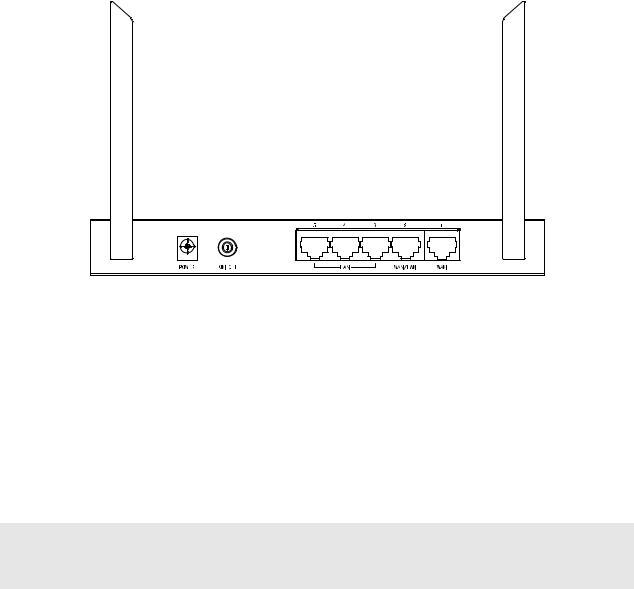
Reset button
Use the button to restore the Router to the factory defaults. With the Router powered on, use a pin to press and hold the Reset button (about 4~5 seconds). After the SYS LED goes out, release the Reset button. If the SYS LED is flashing with a high frequency about two or three seconds, it means the Router is restored successfully.
Wifi button
Press this button to enable or disable WI-FI.
2.3.2 Rear Panel
The rear panel of TL-ER604W is shown as the following figure.
Figure 2-2 Rear Panel
Antenna
The router provides two external detachable antennas for receiving and transmitting the wireless data.
Power
The power socket is where you will connect the power adapter. Please use the power adapter provided with this TL-ER604W SafeStream Wireless N Gigabit Broadband VPN Router.
On/Off
Press this button to turn on or turn off the Router.
 Note:
Note:
Please use only the power cord provided with this Router.
-7-
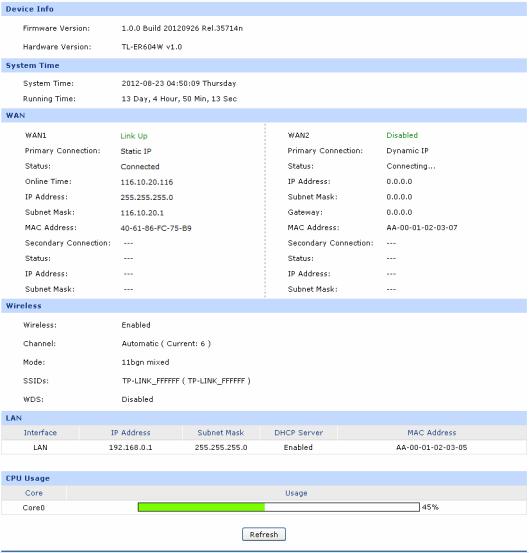
Chapter 3 Configuration
3.1 Network
3.1.1 Status
The Status page shows the system information, the port connection status and other information related to this Router.
Choose the menu Network→Status to load the following page.
Figure 3-1 Status
3.1.2 System Mode
The TL-ER604W Router can work in three modes: NAT, Non-NAT and Classic.
If your Router is hosting your local network’s connection to the Internet with a network topology as the Figure 3-2 shown, you can set it to NAT mode.
-8-

Figure 3-2 Network Topology - NAT Mode
If your Router is connecting the two networks of different areas in a large network environment with a network topology as the Figure 3-3 shown, and forwards the packets between these two networks by the Routing rules, you can set it to Non-NAT mode.
Figure 3-3 Network Topology – Non-NAT Mode
If your Router is connected in a combined network topology as the Figure 3-4 shown, you can set it to Classic Mode.
Figure 3-4 Network Topology – Classic Mode
Choose the menu Network→System Mode to load the following page.
-9-

Figure 3-5 System Mode
You can select a System Mode for your Router according to your network need.
NAT Mode
NAT (Network Address Translation) mode allows the Router to translate private IP addresses within internal networks to public IP addresses for traffic transport over external networks, such as the Internet. Incoming traffic is translated back for delivery within the internal network. However, the Router will drop all the packets whose source IP addresses are in different subnet of LAN port. For example: If the LAN port of the Router is set to 192.168.0.1 for IP address and 255.255.255.0 for the Subnet Mask, then the subnet of LAN port is 192.168.0.0/24. The packet with 192.168.0.123 as its source IP address can be transported by NAT, whereas the packet with 20.31.76.80 as its source IP address will be dropped.
Non-NAT Mode
In this mode, the Router functions as the traditional Gateway and forwards the packets via routing protocol. The Hosts in different subnets can communicate with one another via the routing rules whereas no NAT is employed.
 Note:
Note:
In Non-NAT mode, all the NAT forwarding rules will be disabled.
Classic Mode
It's the combined mode of NAT mode and Non-NAT mode. In Classic mode, the Router will first transport the packets which are compliant with NAT forwarding rules and then match the other packets to the static routing rules. The matched packets will be transmitted based on the static routing rules and the unmatched ones will be dropped. In this way, the Router can implement NAT for the packets without blocking the packets in the different subnet of the ports.
3.1.3 WAN
3.1.3.1WAN Mode
TL-ER604W provides two adjustable WAN ports. You can set the number of WAN ports on this page.
Choose the menu Network→WAN→WAN Mode to load the following page.
-10-
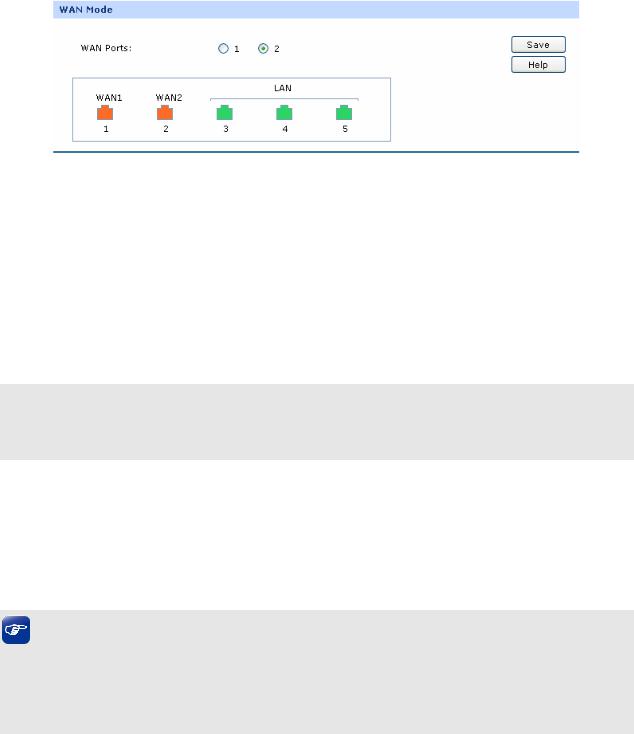
Figure 3-6 WAN Mode
WAN Mode
WAN Ports: Select the total number of WAN ports you prefer to use. The Router support one WAN and dual WAN. The Router will adjust the physical ports accordingly, which can be illustrated on the following port sketch.
 Note:
Note:
By default, TL-ER604W is set to work in the mode of dual WAN ports.
3.1.3.2WAN1
TL-ER604W provides the following six Internet connection types: Static IP, Dynamic IP, PPPoE/Russian PPPoE, L2TP/Russian L2TP, PPTP/Russian PPTP and BigPond. To configure the WAN, please first select the type of Internet connection provided by your ISP (Internet Service Provider).
Tips:
It’s allowed to set the IP addresses of both the WAN ports within the same subnet. However, to guarantee a normal communication, make sure that the WAN ports can access the same network, such as Internet or a local area network.
Choose the menu Network→WAN→WAN1 to load the configuration page.
1)Static IP
If a static IP address has been provided by your ISP, please choose the Static IP connection type to configure the parameters for WAN port manually.
-11-

Figure 3-7 WAN – Static IP
The following items are displayed on this screen:
Static IP
Connection Type: Select Static IP if your ISP has assigned a static IP address for your computer.
IP Address: Enter the IP address assigned by your ISP. If you are not clear, please consult your ISP.
Subnet Mask: Enter the Subnet Mask assigned by your ISP.
Default Gateway: Optional. Enter the Gateway assigned by your ISP.
MTU: MTU (Maximum Transmission Unit) is the maximum data unit transmitted by the physical network. It can be set in the range of 576-1500. The default MTU is 1500. It is recommended to keep the default value if no other MTU value is provided by your ISP.
Primary DNS: Enter the IP address of your ISP’s Primary DNS (Domain Name Server). If you are not clear, please consult your ISP. It’s not allowed to access the Internet via domain name if the Primary DNS field is blank.
Secondary DNS: Optional. If a Secondary DNS Server address is available, enter it.
Upstream Bandwidth: Specify the bandwidth for transmitting packets on the port.
-12-
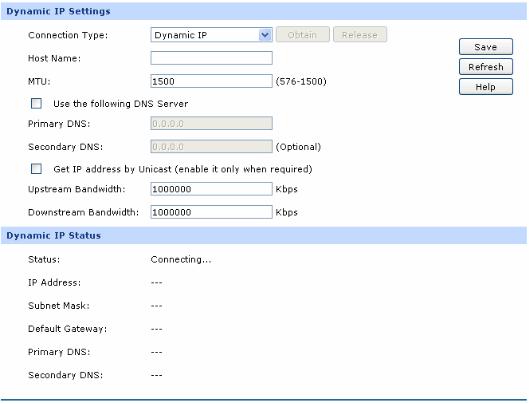
Downstream Bandwidth: Specify the bandwidth for receiving packets on the port.
2)Dynamic IP
If your ISP (Internet Service Provider) assigns the IP address automatically, please choose the Dynamic IP connection type to obtain the parameters for WAN port automatically.
Figure 3-8 WAN – Dynamic IP
The following items are displayed on this screen:
Dynamic IP
Connection Type: |
Select Dynamic IP if your ISP assigns the IP address |
|
automatically. Click <Obtain> to get the IP address from your |
|
ISP’s server. Click <Release> to release the current IP address of |
|
WAN port. |
Host Name: |
Optional. This field allows you to give a name for the Router. It's |
|
blank by default. |
MTU: |
MTU (Maximum Transmission Unit) is the maximum data unit |
|
transmitted by the physical network. It can be set in the range of |
|
576-1500. The default MTU is 1500. It is recommended to keep |
|
-13- |
|
the default value if no other MTU value is provided by your ISP. |
Get IP Address by |
The broadcast requirement may not be supported by a few ISPs. |
Unicast: |
Select this option if you can not get the IP address from your ISP |
|
even if with a normal network connection. This option is not |
|
required generally. |
Use the following DNS |
Select this option to enter the DNS (Domain Name Server) |
Server: |
address manually. |
Primary DNS: |
Enter the IP address of your ISP’s Primary DNS (Domain Name |
|
Server). If you are not clear, please consult your ISP. |
Secondary DNS: |
Optional. If a Secondary DNS Server address is available, enter |
|
it. |
Upstream Bandwidth: |
Specify the bandwidth for transmitting packets on the port. |
Downstream |
Specify the bandwidth for receiving packets on the port. |
Bandwidth: |
|
Dynamic IP Status |
|
Status: |
Displays the status of obtaining an IP address from your ISP. |
|
“Disabled” indicates that the Dynamic IP connection type is not |
|
applied. |
|
“Connecting” indicates that the Router is obtaining the IP |
|
parameters from your ISP. |
|
“Connected” indicates that the Router has successfully |
|
obtained the IP parameters from your ISP. |
|
“Disconnected” indicates that the IP address has been |
|
manually released or the request of the Router gets no response |
|
from your ISP. Please check your network connection and consult |
|
your ISP if this problem remains. |
IP Address: |
Displays the IP address assigned by your ISP. |
Subnet Mask: |
Displays the Subnet Mask assigned by your ISP. |
|
-14- |
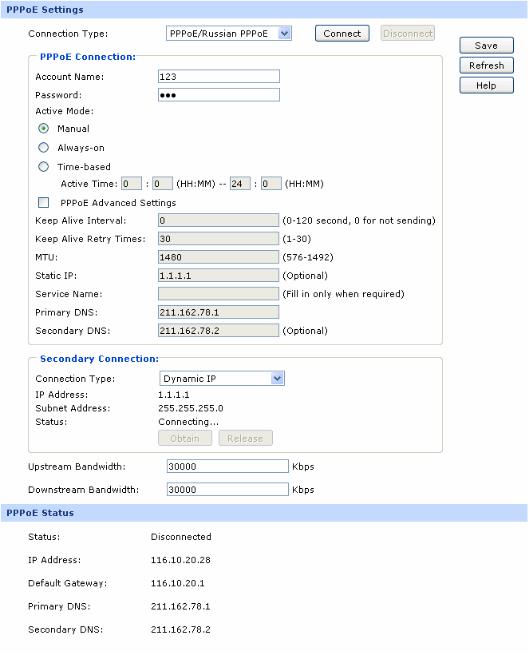
Gateway Address: Displays the Gateway Address assigned by your ISP.
Primary DNS: Displays the IP address of your ISP’s Primary DNS.
Secondary DNS: Displays the IP address of your ISP’s Secondary DNS.
3)PPPoE
If your ISP (Internet Service Provider) has provided the account information for the PPPoE connection, please choose the PPPoE connection type (Used mainly for DSL Internet service).
Figure 3-9 WAN - PPPoE
-15-
The following items are displayed on this screen:
PPPoE Settings
Connection Type: Select PPPoE if your ISP provides xDSL Virtual Dial-up connection.
Click <Connect> to dial-up to the Internet and obtain the IP address. Click <Disconnect> to disconnect the Internet connection and release the current IP address.
Account Name: |
Enter the Account Name provided by your ISP. If you are not clear, |
|
please consult your ISP. |
Password: |
Enter the Password provided by your ISP. |
Active Mode: |
You can select the proper Active mode according to your need. |
|
Manual: Select this option to manually activate or terminate the |
|
Internet connection by the <Connect> or <Disconnect> button. |
|
It is optimum for the dial-up connection charged on time. |
|
Always-on: Select this option to keep the connection always |
|
on. The connection can be re-established automatically when it |
|
is down. |
|
Time-based: Select this option to keep the connection on |
|
during the Active time you set. |
PPPoE Advanced |
Check here to enable PPPoE advanced settings. |
Settings: |
|
Keep Alive: |
Once PPPoE is connected, the Router will send keep-alive packets |
|
every "Keep Alive Interval" sec and "Keep Alive Retry Times" to |
|
make sure the connection is still alive. If the Router does not get the |
|
response from ISP after sending keep-alive packets, then the |
|
Router will terminate the connection. |
MTU: |
MTU (Maximum Transmission Unit) is the maximum data unit |
|
transmitted by the physical network. It can be set in the range of |
|
576-1492. The default MTU is 1480. It is recommended to keep the |
|
default value if no other MTU value is provided by your ISP. |
-16-
ISP Address: |
Optional. Enter the ISP address provided by your ISP. It's null by |
|
default. |
Service Name: |
Optional. Enter the Service Name provided by your ISP. It's null by |
|
default. |
Primary DNS: |
Enter the IP address of your ISP’s Primary DNS. |
Secondary DNS: |
Optional. Enter the IP address of your ISP’s Secondary DNS. |
Secondary Connection: |
Here allows you to configure the secondary connection. Dynamic IP |
|
and Static IP connection types are provided. |
Connection Type: |
Select the secondary connection type. Options include Disable, |
|
Dynamic IP and Static IP. |
IP Address: |
If Static IP is selected, configure the IP address of WAN port. If |
|
Dynamic IP is selected, the obtained IP address of WAN port is |
|
displayed. |
Subnet Address: |
If Static IP is selected, configure the subnet address of WAN port. If |
|
Dynamic IP is selected, the obtained subnet address of WAN port is |
|
displayed. |
Status: |
Displays the status of secondary connection. |
Upstream Bandwidth: |
Specify the bandwidth for transmitting packets on the port. |
Downstream Bandwidth: |
Specify the bandwidth for receiving packets on the port. |
PPPoE Status |
|
Status: |
Displays the status of PPPoE connection. |
|
“Disabled” indicates that the PPPoE connection type is not |
|
applied. |
|
“Connecting” indicates that the Router is obtaining the IP |
|
parameters from your ISP. |
|
-17- |
|
|
“Connected” indicates that the Router has |
successfully |
|
|
obtained the IP parameters from your ISP. |
|
|
|
“Disconnected” indicates that the connection |
has been |
|
|
manually terminated or the request of the Router has no |
|
|
|
response from your ISP. Please ensure that your settings are |
|
|
|
correct and your network is connected well. Consult your ISP if |
|
|
|
this problem remains. |
|
IP Address: |
Displays the IP address assigned by your ISP. |
|
|
Gateway Address: |
Displays the Gateway Address assigned by your ISP. |
|
|
Primary DNS: |
Displays the IP address of your ISP’s Primary DNS. |
|
|
Secondary DNS: |
Displays the IP address of your ISP’s Secondary DNS. |
|
|
4)L2TP
If your ISP (Internet Service Provider) has provided the account information for the L2TP connection, please choose the L2TP connection type.
-18-

Figure 3-10 WAN - L2TP
The following items are displayed on this screen:
L2TP Settings
Connection Type: Select L2TP if your ISP provides a L2TP connection. Click <Connect> to dial-up to the Internet and obtain the IP address. Click <Disconnect> to disconnect the Internet connection and release the current IP address.
Account Name: Enter the Account Name provided by your ISP. If you are not clear, please consult your ISP.
Password: Enter the Password provided by your ISP.
Server IP: Enter the Server IP provided by your ISP.
-19-
MTU: |
MTU (Maximum Transmission Unit) is the maximum data unit |
|
transmitted by the physical network. It can be set in the range of |
|
576-1460. The default MTU is 1460. It is recommended to keep the |
|
default value if no other MTU value is provided by your ISP. |
Active Mode: |
You can select the proper Active Mode according to your need. |
|
Manual: Select this option to manually activate or terminate the |
|
Internet connection by the <Connect> or <Disconnect> button. It |
|
is optimum for the dial-up connection charged on time. |
|
Always-on: Select this option to keep the connection always on. |
|
The connection can be re-established automatically when it is |
|
down. |
Secondary |
Here allows you to configure the secondary connection. Dynamic IP |
Connection: |
and Static IP connection types are provided. |
Connection Type: |
Select the secondary connection type. Options include Disable, |
|
Dynamic IP and Static IP. |
IP Address: |
If Static IP is selected, configure the IP address of WAN port. If |
|
Dynamic IP is selected, the IP address of WAN port obtained is |
|
displayed. |
Subnet Mask: |
If Static IP is selected, configure the subnet mask of WAN port. If |
|
Dynamic IP is select, the subnet mask of WAN port obtained is |
|
displayed. |
Default Gateway: |
If Static IP is selected, configure the default gateway. If Dynamic IP is |
|
selected, the obtained default gateway is displayed. |
Primary DNS/ |
If Static IP is selected, configure the DNS. If Dynamic IP is selected, |
Secondary DNS: |
the obtained DNS is displayed. |
Upstream Bandwidth: |
Specify the bandwidth for transmitting packets on the port. |
Downstream |
Specify the bandwidth for receiving packets on the port. |
Bandwidth: |
|
|
-20- |
L2TP Status |
|
Status: |
Displays the status of PPPoE connection. |
|
“Disabled” indicates that the L2TP connection type is not applied. |
|
“Connecting” indicates that the Router is obtaining the IP |
|
parameters from your ISP. |
|
“Connected” indicates that the Router has successfully obtained |
|
the IP parameters from your ISP. |
|
“Disconnected” indicates that the connection has been manually |
|
terminated or the request of the Router has no response from |
|
your ISP. Please ensure that your settings are correct and your |
|
network is connected well. Consult your ISP if this problem |
|
remains. |
IP Address: |
Displays the IP address assigned by your ISP. |
Primary DNS: |
Displays the IP address of your ISP’s Primary DNS. |
Secondary DNS: |
Displays the IP address of your ISP’s Secondary DNS. |
5)PPTP
If your ISP (Internet Service Provider) has provided the account information for the PPTP connection, please choose the PPTP connection type.
-21-
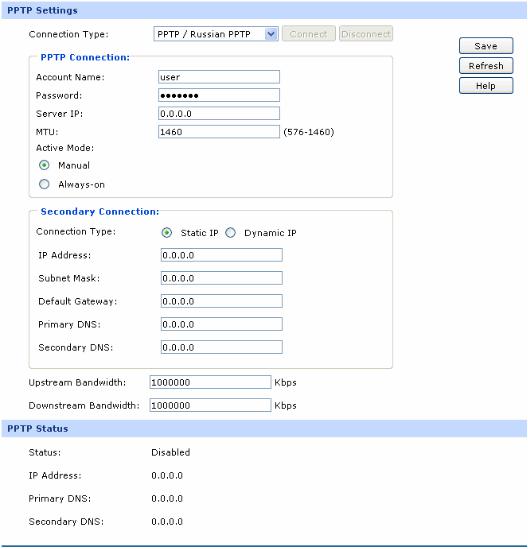
Figure 3-11 WAN - PPTP
The following items are displayed on this screen:
PPTP Settings |
|
Connection Type: |
Select PPTP if your ISP provides a PPTP connection. Click |
|
<Connect> to dial-up to the Internet and obtain the IP address. |
|
Click <Disconnect> to disconnect the Internet connection and |
|
release the current IP address. |
Account Name: |
Enter the Account Name provided by your ISP. If you are not |
|
clear, please consult your ISP. |
Password: |
Enter the Password provided by your ISP. |
Server IP: |
Enter the Server IP provided by your ISP. |
|
-22- |
MTU: |
MTU (Maximum Transmission Unit) is the maximum data unit |
|
transmitted by the physical network. It can be set in the range of |
|
576-1460. The default MTU is 1460. It is recommended to keep |
|
the default value if no other MTU value is provided by your ISP. |
Active Mode: |
You can select the proper Active mode according to your need. |
|
Manual: Select this option to manually activate or terminate |
|
the Internet connection by the <Connect> or <Disconnect> |
|
button. It’s optimum for the dial-up connection charged on |
|
time. |
|
Always-on: Select this option to keep the connection always |
|
on. The connection can be re-established automatically |
|
when it is down. |
Secondary Connection: |
Here allows you to configure the secondary connection. |
|
Dynamic IP and Static IP connection types are provided. |
Connection Type: |
Select the secondary connection type. Options include Disable, |
|
Dynamic IP and Static IP. |
IP Address: |
If Static IP is selected, configure the IP address of WAN port. If |
|
Dynamic IP is selected, the IP address of WAN port obtained is |
|
displayed. |
Subnet Mask: |
If Static IP is selected, configure the subnet mask of WAN port. If |
|
Dynamic IP is select, the subnet mask of WAN port obtained is |
|
displayed. |
Default Gateway:
Primary DNS/
Secondary DNS:
Upstream Bandwidth:
Downstream Bandwidth:
If Static IP is selected, configure the default gateway. If Dynamic IP is selected, the obtained default gateway is displayed.
If Static IP is selected, configure the DNS. If Dynamic IP is selected, the obtained DNS is displayed.
Specify the bandwidth for transmitting packets on the port.
Specify the bandwidth for receiving packets on the port.
-23-
PPTP Status |
|
Status: |
Displays the status of PPTP connection. |
|
“Disabled” indicates that the PPTP connection type is not |
|
applied. |
|
“Connecting” indicates that the Router is obtaining the IP |
|
parameters from your ISP. |
|
“Connected” indicates that the Router has successfully obtained |
|
the IP parameters from your ISP. |
|
“Disconnected” indicates that the connection has been manually |
|
terminated or the request of the Router has no response from |
|
your ISP. Please ensure that your settings are correct and your |
|
network is connected well. Consult your ISP if this problem |
|
remains. |
IP Address: |
Displays the IP address assigned by your ISP. |
Primary DNS: |
Displays the IP address of your ISP’s Primary DNS. |
Secondary DNS: |
Displays the IP address of your ISP’s Secondary DNS. |
6)BigPond
If your ISP (Internet Service Provider) has provided the account information for the BigPond connection, please choose the BigPond connection type.
-24-
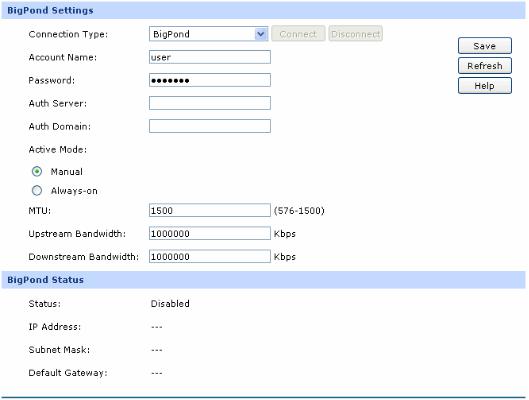
Figure 3-12 WAN – Bigpond
The following items are displayed on this screen:
BigPond Settings
Connection Type: Select BigPond if your ISP provides a BigPond connection. Click <Connect> to dial-up to the Internet and obtain the IP address. Click <Disconnect> to disconnect the Internet connection and release the current IP address.
Account Name: Enter the Account Name provided by your ISP. If you are not clear, please consult your ISP.
Password: Enter the Password provided by your ISP. If you are not clear, please consult your ISP.
Auth Server: Enter the address of authentication server. It can be IP address or server name.
Auth Domain: Enter the domain name of authentication server. It's only required when the address of Auth Server is a server name.
-25-
